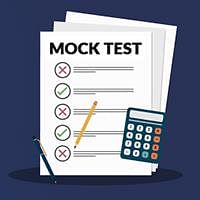CLAT Exam > CLAT Questions > Directions: In the following questions, a sta...
Start Learning for Free
Directions: In the following questions, a statement or two are followed by two conclusions.
Statement:
Inspite of the claim of the government that terrorism is under check, killing continues.
Conclusions:
I. The terrorists have not come to an understanding with the government.
II. The government has been constantly telling a lie.
Statement:
Inspite of the claim of the government that terrorism is under check, killing continues.
Conclusions:
I. The terrorists have not come to an understanding with the government.
II. The government has been constantly telling a lie.
- a)if conclusion I follows;
- b)if conclusion II follows;
- c)if both I and II follow;
- d)if either I or II follows; and
- e)if neither I nor II follows.
Correct answer is option 'C'. Can you explain this answer?
| FREE This question is part of | Download PDF Attempt this Test |
Verified Answer
Directions: In the following questions, a statement or two are followe...
Both conclusions are correct. Killing continues, means the first conclusion is valid. Killing continues while the government says that terrorists are in check, means that the second is valid.
Most Upvoted Answer
Directions: In the following questions, a statement or two are followe...
Statement and Conclusions:
Statement: Inspite of the claim of the government that terrorism is under check, killing continues.
Conclusions:
I. The terrorists have not come to an understanding with the government.
II. The government has been constantly telling a lie.
Explanation:
The statement talks about the government's claim that terrorism is under check, but killing continues, which indicates that the claim is not true. Based on this statement, we can draw the following conclusions:
Conclusion I: The terrorists have not come to an understanding with the government
This conclusion can be drawn as the statement suggests that terrorism is still ongoing, indicating that the terrorists are not cooperating with the government to bring an end to it.
Conclusion II: The government has been constantly telling a lie
This conclusion can also be drawn as the statement indicates that the government's claim that terrorism is under check is false, which implies that the government has been lying to the people.
Therefore, both conclusions I and II can be drawn from the given statement. Hence, the correct answer is option C, i.e., both I and II follow.
Statement: Inspite of the claim of the government that terrorism is under check, killing continues.
Conclusions:
I. The terrorists have not come to an understanding with the government.
II. The government has been constantly telling a lie.
Explanation:
The statement talks about the government's claim that terrorism is under check, but killing continues, which indicates that the claim is not true. Based on this statement, we can draw the following conclusions:
Conclusion I: The terrorists have not come to an understanding with the government
This conclusion can be drawn as the statement suggests that terrorism is still ongoing, indicating that the terrorists are not cooperating with the government to bring an end to it.
Conclusion II: The government has been constantly telling a lie
This conclusion can also be drawn as the statement indicates that the government's claim that terrorism is under check is false, which implies that the government has been lying to the people.
Therefore, both conclusions I and II can be drawn from the given statement. Hence, the correct answer is option C, i.e., both I and II follow.
Attention CLAT Students!
To make sure you are not studying endlessly, EduRev has designed CLAT study material, with Structured Courses, Videos, & Test Series. Plus get personalized analysis, doubt solving and improvement plans to achieve a great score in CLAT.

|
Explore Courses for CLAT exam
|

|
Similar CLAT Doubts
Directions: In the following questions, a statement or two are followed by two conclusions.Statement:Inspite of the claim of the government that terrorism is under check, killing continues.Conclusions:I. The terrorists have not come to an understanding with the government.II. The government has been constantly telling a lie.a)if conclusion I follows;b)if conclusion II follows;c)if both I and II follow;d)if either I or II follows; ande)if neither I nor II follows.Correct answer is option 'C'. Can you explain this answer?
Question Description
Directions: In the following questions, a statement or two are followed by two conclusions.Statement:Inspite of the claim of the government that terrorism is under check, killing continues.Conclusions:I. The terrorists have not come to an understanding with the government.II. The government has been constantly telling a lie.a)if conclusion I follows;b)if conclusion II follows;c)if both I and II follow;d)if either I or II follows; ande)if neither I nor II follows.Correct answer is option 'C'. Can you explain this answer? for CLAT 2024 is part of CLAT preparation. The Question and answers have been prepared according to the CLAT exam syllabus. Information about Directions: In the following questions, a statement or two are followed by two conclusions.Statement:Inspite of the claim of the government that terrorism is under check, killing continues.Conclusions:I. The terrorists have not come to an understanding with the government.II. The government has been constantly telling a lie.a)if conclusion I follows;b)if conclusion II follows;c)if both I and II follow;d)if either I or II follows; ande)if neither I nor II follows.Correct answer is option 'C'. Can you explain this answer? covers all topics & solutions for CLAT 2024 Exam. Find important definitions, questions, meanings, examples, exercises and tests below for Directions: In the following questions, a statement or two are followed by two conclusions.Statement:Inspite of the claim of the government that terrorism is under check, killing continues.Conclusions:I. The terrorists have not come to an understanding with the government.II. The government has been constantly telling a lie.a)if conclusion I follows;b)if conclusion II follows;c)if both I and II follow;d)if either I or II follows; ande)if neither I nor II follows.Correct answer is option 'C'. Can you explain this answer?.
Directions: In the following questions, a statement or two are followed by two conclusions.Statement:Inspite of the claim of the government that terrorism is under check, killing continues.Conclusions:I. The terrorists have not come to an understanding with the government.II. The government has been constantly telling a lie.a)if conclusion I follows;b)if conclusion II follows;c)if both I and II follow;d)if either I or II follows; ande)if neither I nor II follows.Correct answer is option 'C'. Can you explain this answer? for CLAT 2024 is part of CLAT preparation. The Question and answers have been prepared according to the CLAT exam syllabus. Information about Directions: In the following questions, a statement or two are followed by two conclusions.Statement:Inspite of the claim of the government that terrorism is under check, killing continues.Conclusions:I. The terrorists have not come to an understanding with the government.II. The government has been constantly telling a lie.a)if conclusion I follows;b)if conclusion II follows;c)if both I and II follow;d)if either I or II follows; ande)if neither I nor II follows.Correct answer is option 'C'. Can you explain this answer? covers all topics & solutions for CLAT 2024 Exam. Find important definitions, questions, meanings, examples, exercises and tests below for Directions: In the following questions, a statement or two are followed by two conclusions.Statement:Inspite of the claim of the government that terrorism is under check, killing continues.Conclusions:I. The terrorists have not come to an understanding with the government.II. The government has been constantly telling a lie.a)if conclusion I follows;b)if conclusion II follows;c)if both I and II follow;d)if either I or II follows; ande)if neither I nor II follows.Correct answer is option 'C'. Can you explain this answer?.
Solutions for Directions: In the following questions, a statement or two are followed by two conclusions.Statement:Inspite of the claim of the government that terrorism is under check, killing continues.Conclusions:I. The terrorists have not come to an understanding with the government.II. The government has been constantly telling a lie.a)if conclusion I follows;b)if conclusion II follows;c)if both I and II follow;d)if either I or II follows; ande)if neither I nor II follows.Correct answer is option 'C'. Can you explain this answer? in English & in Hindi are available as part of our courses for CLAT.
Download more important topics, notes, lectures and mock test series for CLAT Exam by signing up for free.
Here you can find the meaning of Directions: In the following questions, a statement or two are followed by two conclusions.Statement:Inspite of the claim of the government that terrorism is under check, killing continues.Conclusions:I. The terrorists have not come to an understanding with the government.II. The government has been constantly telling a lie.a)if conclusion I follows;b)if conclusion II follows;c)if both I and II follow;d)if either I or II follows; ande)if neither I nor II follows.Correct answer is option 'C'. Can you explain this answer? defined & explained in the simplest way possible. Besides giving the explanation of
Directions: In the following questions, a statement or two are followed by two conclusions.Statement:Inspite of the claim of the government that terrorism is under check, killing continues.Conclusions:I. The terrorists have not come to an understanding with the government.II. The government has been constantly telling a lie.a)if conclusion I follows;b)if conclusion II follows;c)if both I and II follow;d)if either I or II follows; ande)if neither I nor II follows.Correct answer is option 'C'. Can you explain this answer?, a detailed solution for Directions: In the following questions, a statement or two are followed by two conclusions.Statement:Inspite of the claim of the government that terrorism is under check, killing continues.Conclusions:I. The terrorists have not come to an understanding with the government.II. The government has been constantly telling a lie.a)if conclusion I follows;b)if conclusion II follows;c)if both I and II follow;d)if either I or II follows; ande)if neither I nor II follows.Correct answer is option 'C'. Can you explain this answer? has been provided alongside types of Directions: In the following questions, a statement or two are followed by two conclusions.Statement:Inspite of the claim of the government that terrorism is under check, killing continues.Conclusions:I. The terrorists have not come to an understanding with the government.II. The government has been constantly telling a lie.a)if conclusion I follows;b)if conclusion II follows;c)if both I and II follow;d)if either I or II follows; ande)if neither I nor II follows.Correct answer is option 'C'. Can you explain this answer? theory, EduRev gives you an
ample number of questions to practice Directions: In the following questions, a statement or two are followed by two conclusions.Statement:Inspite of the claim of the government that terrorism is under check, killing continues.Conclusions:I. The terrorists have not come to an understanding with the government.II. The government has been constantly telling a lie.a)if conclusion I follows;b)if conclusion II follows;c)if both I and II follow;d)if either I or II follows; ande)if neither I nor II follows.Correct answer is option 'C'. Can you explain this answer? tests, examples and also practice CLAT tests.

|
Explore Courses for CLAT exam
|

|
Suggested Free Tests
Signup for Free!
Signup to see your scores go up within 7 days! Learn & Practice with 1000+ FREE Notes, Videos & Tests.
























